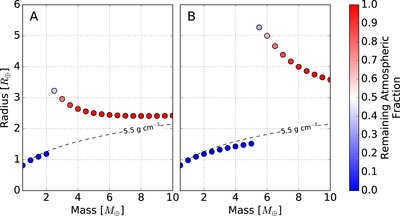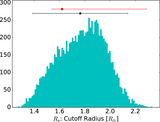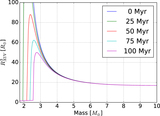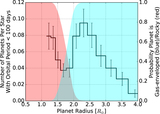Image Details

Caption: Figure 1.
Atmospheric loss from planets between 0.5 and 10 Earth masses over 100 Myr with an initial H2 atmosphere of 3 wt.% at 0.1 au around a young, Sun-like star. The dashed curve shows the contour of fixed Earth-like density of 5.5 g cm−3. Blue dots representing rocky bodies fall below this line due to compression at high mass. In both plots, the model was run with τ = 100 Myr, Rg = 4157 J kg−1 K−1, pXUV = 5 Pa, FXUV = 55 W m−2, η = 0.1, and α = 0.03. The planets in plot (a) had an isothermal atmospheric temperature of T = 880 K (corresponding to the effective temperature at 0.1 au with a Bond albedo of 0), and the temperature was set to T = 1760 K in plot (b). In both cases, we see a sharp cutoff between rocky and gas-enveloped planets occurring in the 1.2 R⊕ to 1.6 R⊕ range.
(An animation of this figure is available.)
The video/animation of this figure is available in the online journal.
Copyright and Terms & Conditions
© 2017. The American Astronomical Society. All rights reserved.







